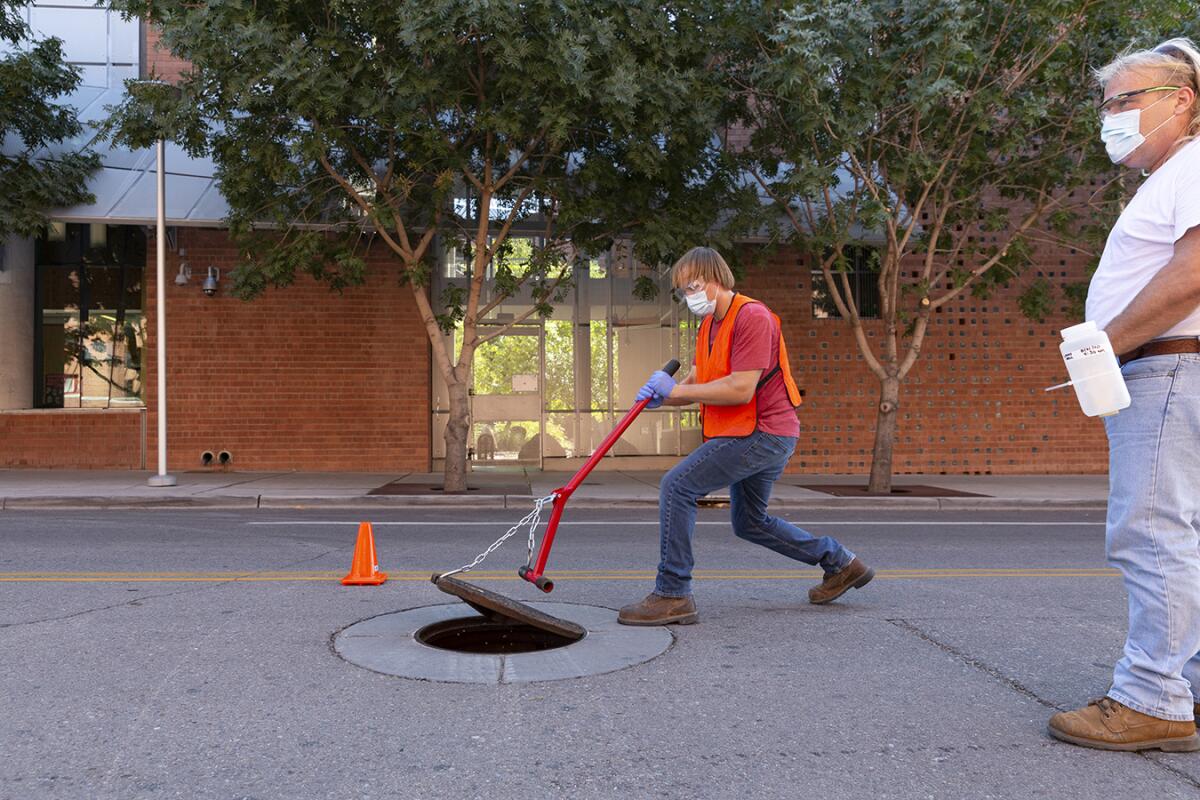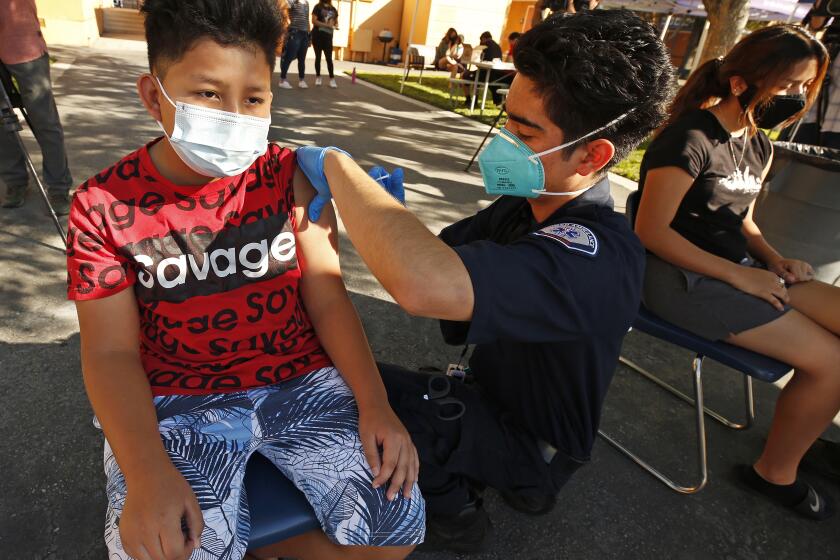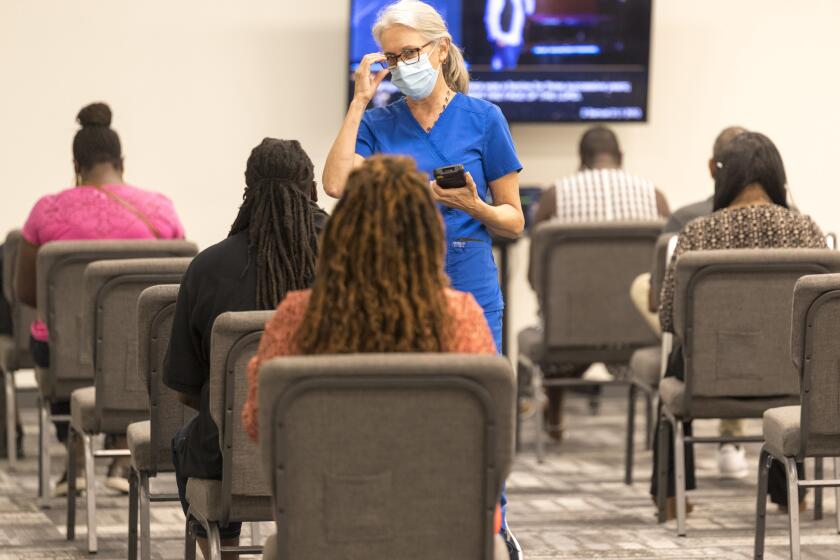A disease detection tool for COVID-19 and beyond: Poop

Since the UC San Diego campus reopened last summer, university officials have relied on the tried-and-true public health strategies of coronavirus testing and contact tracing. They have also added a new tool to their arsenal: excrement.
That tool alerted researchers to about 85% of infections in dorms before they were diagnosed, according to a soon-to-be published study, said Rob Knight, a professor of pediatrics and computer science and engineering at UCSD who helped create the campus’s wastewater testing program.
When the coronavirus is detected in sewage, students, staffers and faculty members are tested, which has allowed the school to identify and isolate infected individuals even if they aren’t showing symptoms — potentially stopping outbreaks in their tracks.
The program is among hundreds of efforts around California and the nation to turn waste into valuable health data.
Researchers have high hopes for this sludgy new data stream, which they say can alert public health officials to trends in infections and doesn’t depend on individuals getting tested. And because people excrete the virus in feces before they have a chance to show symptoms of illness, it can serve as an early warning system for outbreaks.
The Centers for Disease Control and Prevention finds the practice so promising that it has created a federal database of wastewater samples. The program is essentially creating a public health tool in real time, experts say. It could have a range of uses beyond the current global pandemic, including tracking other infectious diseases as well as germs’ resistance to antibiotics.
“We think this can really provide valuable data, not just for COVID, but for a lot of diseases,” said Amy Kirby, a microbiologist leading the CDC effort.
Sewage data analyzed in Silicon Valley wastewater treatment plants confirms that the latest wave of coronavirus infections is sharply worse than the ones in the spring and summer.
The virus that causes COVID-19 infects many types of cells in the body, including those in the respiratory tract and gut. RNA from the virus makes its way into feces soon after an infection begins.
At UCSD and other campuses, researchers take samples flowing from individual buildings, capturing data so granular that they can often deduce the number of infected people living or working there. In most other settings, because of privacy concerns and resource constraints, testing is done on a much larger scale, with the goal of tracking trends over time.
Samples are drawn from wastewater, which is what comes out of our sewer pipes, or sludge, the solids that have settled out of the wastewater. They are typically extracted mechanically or by a human with a dipper on the end of a rod.
When researchers in Davis, Calif., saw the viral load rise in several neighborhood sewage streams in July, they sent out text message alerts and hung signs on the doors of 3,000 homes recommending that people get tested.
Before the pandemic, testing sewage to identify and ward off illness in the U.S. was largely limited to academic use. Israel used it to stave off a polio outbreak in 2013, and some communities in the U.S. were sampling sewage before the pandemic to figure out what kinds of opioids people in their communities were using, a service offered by the company Biobot.
After the coronavirus hit the U.S., local governments scrambled for any information they could get.
A boom in COVID-19 hospitalizations for children has been driven by states like Florida, Texas and Georgia, but the numbers in California have been less dire.
In California’s rural Lake County, health officials had identified a handful of cases by sending nurses out to look for infected people. They were sure there were more but couldn’t get their hands on tests to prove it, so in spring 2020 they signed up for a free sewage testing program run by Biobot, which pivoted to coronavirus testing as the pandemic took off.
Sure enough, the virus turned up in samples at four wastewater treatment facilities in Lake County.
As sewage sampling took off around the world, the U.S. Department of Health and Human Services began awarding grants to wastewater treatment plants in fall 2020. Biobot won a bid to run a second round of that program, testing the sewage of up to 30% of the U.S. population. At least 25 California wastewater treatment plants are participating in the program.
The test data alone don’t provide much value to health officials — they need to be translated to be useful. Scientists are still learning how to read the data, a complicated process that involves understanding the relationships between how much virus people excrete, how many people are using a wastewater system and how much rainwater is running into the system, potentially diluting the sewage, among many other factors.
Since using wastewater to track diseases was not widespread before the pandemic, there’s been a steep and ongoing learning curve.
Beleaguered public health officials have struggled to incorporate the new data into their already overwhelming workloads, but the CDC hopes it can address those issues with its new national system that tracks and translates wastewater data for local governments.
Pfizer is promoting a third-dose booster shot of its COVID-19 vaccine but has not delivered conclusive proof to back up its effectiveness.
Throughout 2020, Kirby, the CDC microbiologist, and engineer Mia Mattioli were a two-person wastewater team inside the agency’s larger 7,000-person COVID-19 response. During that time, academic colleagues generously shared what they knew about wastewater epidemiology, Kirby said.
By September 2020, the pair had launched the National Wastewater Surveillance System, which interprets sampling data for state and local governments. Today, they lead a team of six and have a permanent place in one of the CDC’s departments.
“Every piece of this system had to be built largely from scratch,” Kirby said. “When I look at that, it really amazes me where we are now.”
In the months since the system debuted, it has been able to detect an uptick in cases four to six days before diagnostic testing shows an increase, Kirby said.
She hopes that by the end of next year, the federal monitoring program will be used to check for different pathogens, including E. coli, salmonella, norovirus and a deadly drug-resistant fungus called Candida auris, which has become a global threat and wreaked havoc in hospitals and nursing homes.
The longer these programs are up and running, the more useful they become, said Colleen Naughton, a professor and civil engineer at UC Merced who leads COVIDPoops19, which tracks wastewater monitoring efforts globally. Naughton is working with colleagues at UC Davis to launch monitoring programs near where she works in the Central Valley but is finding that some smaller communities don’t have the resources to conduct testing or sufficient health personnel to analyze or use the data.
As coronavirus infections rise among young Americans, so too have deaths in a population once thought to be largely shielded from the worst of the pandemic.
It’s in these smaller communities with limited access to testing and doctors where the practice may hold the most promise, Naughton said. The pandemic laid bare long-standing inequities among communities that she fears will be perpetuated by the use of this new public health tool.
Privacy concerns also need to be addressed, experts said. Wastewater data haven’t traditionally been considered protected personal health information the way diagnostic tests are. Health officials have managed earlier concerns about wastewater tracking of illicit drug use by sampling from large enough sewage streams to offer anonymity. But testing for certain health problems requires looking at DNA.
“I think that’s going to be a challenge for public communication,” Knight said, “to make sure that’s not perceived as essentially spying on every individual’s genetic secrets.”
Public health and wastewater officials said they are thrilled by the potential of this new tool and are working on ways to address privacy concerns while taking advantage of it.
Greg Kester, director of renewable resource programs at the California Assn. of Sanitation Agencies, wrote to CDC officials in June 2020 asking for a federal surveillance network. He can hardly believe how quickly that call became a reality. And he hopes it is here to stay.
“As vaccination rates increase and we get the variants, it’s still going to be important because clinical testing is decreasing,” Kester said. “We really want to make this part of the infrastructure.”
This story was produced by KHN, which publishes California Healthline, an editorially independent service of the California Health Care Foundation.









